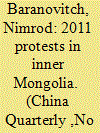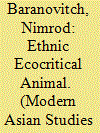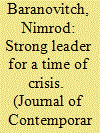|
|
|
Sort Order |
|
|
|
Items / Page
|
|
|
|
|
|
|
| Srl | Item |
| 1 |
ID:
144545


|
|
|
|
|
| Summary/Abstract |
In May 2011, Inner Mongolia experienced the most serious ethnic unrest in the region for 30 years. In this article, I explore the broader context that led to the eruption of the protests, with a particular emphasis on environmental issues. My aim is to explain why environmental issues occupied such a prominent position in the protests, and how these issues were connected to ethnicity. After discussing the material and practical implications of grassland degradation for Mongolian herders, I analyse the symbolic implications of this environmental crisis for the Mongolian educated elite, who have linked environmental issues to ethnic politics and identity. I argue that in the last 20 years or so, Mongolian intellectuals have developed a highly ethnicized environmental discourse, and that this discourse played an important role in informing the 2011 protests. My analysis focuses on this discourse as it is manifested in the domains of art, academia and daily discourse.
|
|
|
|
|
|
|
|
|
|
|
|
|
|
|
|
| 2 |
ID:
179915


|
|
|
|
|
| Summary/Abstract |
Drawing on ideas from ecocriticism, literary animal studies, and post-colonial studies, as well as anthropology and cultural studies, this article examines the representations of animals in contemporary Sino-Mongolian literature and art, and the various connections between these representations and issues related to ethnic and environmental politics. I propose that the intensive engagement of Chinese-Mongolian writers and artists with animals is related first and foremost to the central role that animals, both wild and domesticated, have traditionally played in Mongolian nomadic pastoralist culture. However, I also argue that it is closely connected to two interrelated processes that are currently taking place in Inner Mongolia: the severe degradation of the Inner Mongolian grassland and the rapid sinicization of China's Mongols. I suggest that in the context of this environmental and cultural crisis, the engagement with animals reflects anxiety about the fate of the Inner Mongolian grassland, the fate of real animals, which, for centuries, have been closely associated with this landscape and Mongolian nomadic culture, and, most importantly, the fate of Mongolian culture itself. I also argue that Sino-Mongolian writers and artists use literary and artistic animals to construct and assert Mongolianness as part of their search for an ‘authentic’ ethnic identity, and to comment critically on the impact that Chinese domination has had on the Inner Mongolian grassland, its indigenous human and non-human inhabitants, and Mongolian culture and identity. Finally, I propose that through their ethnic environmentalism, Chinese-Mongolian artists and writers have made an important contribution to the development of China's environmental movement.
|
|
|
|
|
|
|
|
|
|
|
|
|
|
|
|
| 3 |
ID:
178767


|
|
|
|
|
| Summary/Abstract |
Seeking to explain the reasons for the swift shift from collective leadership to strongman rule during Xi Jinping’s early years in office, this article argues that it was the result of a widely shared consensus among China’s ruling elite that the regime was facing a severe crisis that necessitated a return to such rule. This argument challenges the widely held view that the dramatic centralization of power in Xi’s hands was the result mainly of his individual personality, motives, and actions. While many of the factual details that this article presents are not new, it is the first to systematically integrate many of these facts to create a coherent explanation of China’s surprising abandonment of the collective leadership model that goes beyond Xi’s individual role.
|
|
|
|
|
|
|
|
|
|
|
|
|
|
|
|
|
|
|
|
|